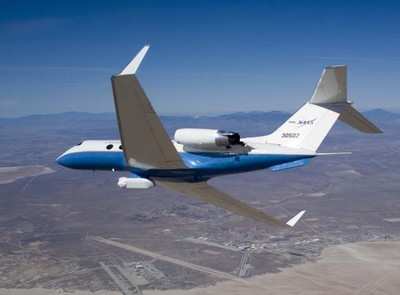UAV-Mounted Sensor May Detect Landslides, Fault Lines
NASA is evaluating a compact L-Band synthetic aperture radar for
potential use on unmanned aircraft. The sensor detects and measures
small changes in the Earth's surface of geophysical interest, such
as volcanoes, earthquake faults, landslides and glaciers.

NASA's Dryden Flight Research Center in Edwards, CA -- along
with the Jet Propulsion Laboratory (JPL) in Pasadena -- are working
to develop the Unmanned Aerial Vehicle Synthetic Aperture Radar
(UAVSAR). A modified NASA Gulfstream III aircraft carries the
JPL-developed radar in a custom-built pod under the aircraft's
fuselage during its development phase.
"The system is an imaging radar. It is like a camera that uses
microwaves to make an image," said Scott Hensley, chief scientist
for the UAVSAR project. "It collects data to measure the
deformation of the Earth's surface, for example from an earthquake
or volcano. This will help us better understand how earthquakes and
volcanoes work. The way we do that is through the signatures of how
they deform the Earth's surface."
 "The UAVSAR is a flying testbed for
developing the tools and technologies for future space- based
radars," said Robert Smith, UAVSAR program manager for NASA's Earth
Science Technology Office. "Once operational, it will also be a
powerful airborne instrument providing calibration data and rapidly
repeated images scientists need to augment data obtained from
satellites."
"The UAVSAR is a flying testbed for
developing the tools and technologies for future space- based
radars," said Robert Smith, UAVSAR program manager for NASA's Earth
Science Technology Office. "Once operational, it will also be a
powerful airborne instrument providing calibration data and rapidly
repeated images scientists need to augment data obtained from
satellites."
During these validation flights, the aircraft is using a
technique known as repeat pass interferometry that requires the
aircraft to fly each pass as close to the original flight line as
possible. For the UAVSAR experiment, two data passes, flown from
minutes to months apart, are compared to examine changes in the
Earth's surface. Flying this technique enables the data collected
by the synthetic aperture radar to be converted into surface
displacement measurements with a sensitivity equal to a fractional
part of the radar wavelength.
To ensure the accuracy of the flight paths, a precision
autopilot designed by engineers at Dryden has been installed on the
test aircraft. The autopilot guides the aircraft using the
differential Global Positioning System and the aircraft's inertial
navigation system to repeat the flight path to an accuracy of
within 15 feet.
With the precision autopilot engaged, the synthetic aperture
radar will be able to acquire repeat pass data that can measure
changes with a resolution measured in millimeters.
"We're very pleased with the performance of the Platform
Precision Autopilot, and feel confident that this new system, along
with the structurally modified G-III aircraft, is ready to fully
support UAVSAR interferometry studies," said Frank Cutler, project
manager for the Gulfstream III UAVSAR flight testing at NASA
Dryden.
During the 1990s scientists used NASA's DC-8 airborne science
laboratory to collect data with the airborne synthetic aperture
radar
(AIRSAR) system, also developed at JPL. The UAVSAR instrument
currently under development has benefited from technology
advancements in the 20 years since AIRSAR was built.
The prototype UAVSAR is smaller, fitting into a pod about 10
feet in length. The radar pod is a self-contained instrument
package that requires only electrical power from the aircraft. The
instrument has its own navigation system consisting of a
high-accuracy inertial navigation unit and a differential GPS
developed at JPL that provides the aircraft's location to an
accuracy of less than three feet. The radar's electronically
steered antenna compensates for aircraft attitude changes as the
radar makes repeated passes over areas of interest.
The pod also contains a two-terabyte recorder to store the large
amounts of data generated by the radar. The pod is designed to
operate autonomously by loading commands to the system's computer
prior to flight. Along with the autopilot, the design of the pod
allows it to be flown on a variety of aircraft, including unmanned
aircraft.

The sensor is currently undergoing a one-year development and
test period to improve robustness and validate its ability to meet
the science objectives. The UAVSAR will be extensively tested
through 2008, after which it will become a community science tool
for NASA.
NASA's Science Mission Directorate funded development of the
UAVSAR.
 Classic Aero-TV: The Switchblade Flying Car FLIES!
Classic Aero-TV: The Switchblade Flying Car FLIES! ANN FAQ: Q&A 101
ANN FAQ: Q&A 101 ANN's Daily Aero-Term (04.12.24): Discrete Code
ANN's Daily Aero-Term (04.12.24): Discrete Code ANN's Daily Aero-Term (04.13.24): Beyond Visual Line Of Sight (BVLOS)
ANN's Daily Aero-Term (04.13.24): Beyond Visual Line Of Sight (BVLOS) ANN's Daily Aero-Linx (04.13.24)
ANN's Daily Aero-Linx (04.13.24)





